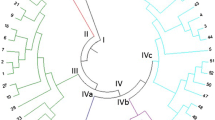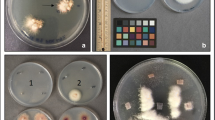Abstract
The aim of this research was to study levels of resistance to Fusarium basal rot in onion cultivars and related Allium species, by using genetically different Fusarium isolates. In order to select genetically different isolates for disease testing, a collection of 61 Fusarium isolates, 43 of them from onion (Allium cepa), was analysed using amplified fragment length polymorphism (AFLP) markers. Onion isolates were collected in The Netherlands (15 isolates) and Uruguay (9 isolates), and received from other countries and fungal collections (19 isolates). From these isolates, 29 were identified as F. oxysporum, 10 as F. proliferatum, whereas the remaining four isolates belonged to F. avenaceum and F. culmorum. The taxonomic status of the species was confirmed by morphological examination, by DNA sequencing of the elongation factor 1-α gene, and by the use of species-specific primers for Fusarium oxysporum, F. proliferatum, and F. culmorum. Within F. oxysporum, isolates clustered in two clades suggesting different origins of F. oxysporum forms pathogenic to onion. These clades were present in each sampled region. Onion and six related Allium species were screened for resistance to Fusarium basal rot using one F. oxysporum isolate from each clade, and one F. proliferatum isolate. High levels of resistance to each isolate were found in Allium fistulosum and A. schoenoprasum accessions, whereas A. pskemense, A. roylei and A. galanthum showed intermediate levels of resistance. Among five A. cepa cultivars, ‘Rossa Savonese’ was also intermediately resistant. Regarding the current feasibility for introgression, A. fistulosum, A. roylei and A. galanthum were identified as potential sources for the transfer of resistance to Fusarium into onion.


Similar content being viewed by others
References
Abawi, G. S., & Lorbeer, J. W. (1971). Pathological histology of four onion cultivars infected by Fusarium oxysporum f. sp. cepae. Phytopathology, 61, 1164–1169.
Baayen, R. P., O’Donnell, K., Bonants, P. J. M., Cigelnik, E., Kroon, L. P., Roebroeck, E. J., et al. (2000a). Gene genealogies and AFLP analysis in the Fusarium oxysporum complex identify monophyletic and nonmonophyletic formae speciales causing wilt and rot disease. Phytopathology, 90, 891–900.
Baayen, R. P., van den Boogert, P. H. J. F., Bonants, P. J. M., Poll, J. T. K., Blok, W. J., & Waalwijk, C. (2000b). Fusarium redolens f.sp. asparagi, causal agent of asparagus root rot, crown rot and spear rot. European Journal of Plant Pathology, 106, 907–912.
Bandyopadhyay, R., Mwangi, M., Aigbe, S. O., & Leslie, J. F. (2006). Fusarium species from the cassava root rot complex in West Africa. Phytopathology, 96, 673–676.
Blancard, D., Villeneuve, F., & Chamont, S. (2003). Le deperissement du peireau: bilan phytosanitaire en 2001. Infos CTIFL, 188, 46–49.
Cox, D. R., & Hinkley, D. V. (1979). Theoretical statistics. London: Chapman and Hall 511 pp..
Cramer, C. S. (2000). Breeding and genetics of Fusarium basal rot resistance in onion. Euphytica, 115, 159–166.
Cramer, C. S. (2006). Onion trait heritability and response from selection. Journal of American Society Horticultural Science, 131, 646–650.
De Melo, P. E. (2003). The root systems of onion and Allium fistulosum in the context of organic farming: a breeding approach. Ph.D. Thesis, Wageningen University and Research Centre, The Netherlands. 136 pp.
Dhingra, O. D., & Coelho Netto, R. A. (2001). Reservoir and non-reservoir hosts of bean-wilt pathogen, Fusarium oxysporum f.sp. phaseoli. Journal of Phytopathology, 149, 463–467.
Dugan, F. M., Hellier, B. C., & Lupien, S. L. (2003). First report of Fusarium proliferatum causing rot of garlic bulbs in North America. Plant Pathology, 52, 426.
du Toit, L. J., Inglis, D. A., & Pelter, G. Q. (2003). Fusarium proliferatum pathogenic on onion bulbs in Washington. Plant Disease, 87, 750.
Entwistle, A. R. (1990). Root diseases. In H. D. Rabinowitch, & J. L. Brewster (Eds.) Onions and allied crops (pp. 103–154). Boca Raton, FL: CRC.
Felsenstein, J. (1985). Confidence limits on phylogenies: an approach using the bootstrap. Evolution, 39, 783–791.
Geiser, D. M., Jiménez-Guasco, M. M., Kang, S., Makalowska, I., Veeraraghavan, N., Ward, T. J., et al. (2004). FUSARIUM-ID v. 1.0: A DNA sequence database for identifying Fusarium. European Journal of Plant Pathology, 110, 473–479.
Gutierrez, J. A., & Cramer, C. S. (2005). Screening short-day onion cultivars for resistance to Fusarium basal rot. HortScience, 40, 157–160.
Holz, G., & Knox-Davies, P. S. (1974). Resistance of onion selections to Fusarium oxysporum f. sp. cepae. Phytophylactica, 6, 153–156.
Kik, C. (2002). Exploitation of wild relatives for the breeding of cultivated Allium species. In H. D. Rabinowitch & L. Currah (Eds.), Allium crop science: Recent advances (p. 81–100). Wallingford: CABI Publishing.
Kistler, H. C. (1997). Genetic diversity in the plant-pathogenic fungus Fusarium oxysporum. Phytopathology, 87, 474–453.
Koike, S. T., Gordon, T. R., & Aegerter, B. J. (2003). Root and basal rot of leek caused by Fusarium culmorum in California. Plant Disease, 87, 601.
Koopman, W. J. M., Zevenbergen, M. J., & van den Berg, R. G. (2001). Species relationships in Lactuca sp. (Lactuceae, Asteraceae) inferred from AFLP fingerprints. American Journal of Botany, 88, 1881–1887.
Krueger, S. K., Weinman, A. A., & Gabelman, W. H. (1989). Combining ability among inbred onions for resistance to Fusarium Basal Rot. Hortscience, 24, 1021–1023.
Mace, E. S., Lester, R. N., & Gebhardt, C. G. (1999). AFLP analysis of genetic relationships among the cultivated eggplant, Solanum melongena L., and wild relatives (Solanaceae). Theoretical and Applied Genetics, 99, 626–633.
McCullagh, R., & Nelder, J. A. (1989). Generalized linear models (2nd ed.). Monographs on Statistics and Applied Probability 37. London: Chapman and Hall, 511p.
Montes, R., Nava, R. A., Flores, H. E., & Mundo, M. (2003). Fungi and nematodes in roots and bulbs of onion (Allium cepa L) in the state of Morelos, Mexico. Revista Mexicana de Fitopatologia, 21, 300–304.
Mulè, G., Susca, A., Stea, G., & Moretti, A. (2004). Specific detection of the toxigenic species Fusarium proliferatum and F. oxysporum from asparagus plants using primers based on calmodulin gene sequences. FEMS Microbiology Letters, 110, 495–502.
Navia, E., & Gómez, J. (1999). Determination of the causal agent of the pink root rot of Welsh onion (Allium fistulosum) in Guambia, municipality of Silvia, department of Cauca. ASCOLFI-Informa, 25, 56.
Nei, M., & Li, W. H. (1979). Mathematical model for studying genetic variation in terms of restriction endonucleases. Proceedings of the National Academy of Sciences USA, 76, 5269–5273.
Nicholson, P., Simpson, D. R., Weston, G., Rezanoor, H. R., Lees, A. K., Parry, D. W., et al. (1998). Detection and quantification of Fusarium culmorum and Fusarium graminearum in cereals using PCR assays. Physiological and Molecular Plant Pathology, 53, 17–37.
O’Donnell, K., Kistler, H. C., Cigelnik, E., & Ploetz, R. C. (1998). Multiple evolutionary origins of the fungus causing Panama disease of banana: concordant evidence from nuclear and mitochondrial gene genealogies. Proceedings of the National Academy of Sciences USA, 95, 2044–2049.
Özer, N., Koycu, D., Chilosi, D., & Magro, P. (2004). Resistance to Fusarium basal rot of onion in greenhouse and field and associated expression of antifungal compounds. Phytoparasitica, 32, 388–394.
Recorbet, G., Steinberg, C., Olivain, C., Edel, V., Trouvelot, S., Dumas-Gaudot, E., et al. (2003). Wanted: pathogenesis-related marker molecules for Fusarium oxysporum. New Phytologist, 159, 73–92.
Shinmura, A. (2002). Studies on the ecology and control of Welsh onion root rot caused by Fusarium redolens. Journal of General Plant Pathology, 68, 265.
Shinmura, A., Sakamoto, N., Hayashi, T., Hoshi, H., & Tanii, A. (1998). Occurrence of Fusarium root rot of Welsh onion caused by F. oxysporum. Bulletin of Hokkaido Prefectural Agricultural Exp. Stat., 74, 35–41.
Simay, E. I. (1990). Garlic rot caused by Fusarium proliferatum (Matsushima) Nirenferg var. minus Nirenferg in Hungary. Novenyvedelem, 26, 397–399.
Stankovic, S., Levic, J., Petrovic, T., Logrieco, A., & Moretti, A. (2007). Pathogenicity and mycotoxin production by Fusarium proliferatum isolated from onion and garlic in Serbia. European Journal of Plant Pathology, 118, 165–172.
Swift, C. E., Wickliffe, E. R., & Schwartz, H. F. (2002). Vegetative compatibility groups of Fusarium oxysporum f. sp. cepae from onion in Colorado. Plant Disease, 86, 606–610.
Valdez, J., Makuch, M. A., & Marini, G. V. (2004). Patogenicidad de aislamientos de Fusarium spp. en plántulas de cebolla (Allium cepa L). 27th Congreso Argentino de Horticultura. Villa de Merlo, Argentina, p. 60.
Van der Peer, Y., & de Watcher, R. (1994). TREECON for Windows: a software package for the construction and drawing of evolutionary trees for the Microsoft Windows environment. Computer Applications in the Biosciences, 10, 569–570.
Van Raamsdonk, L. W. D., Ensink, W., van Heusden, A. W., Vrielink van Ginkel, M., & Kik, C. (2003). Biodiversity assessment based on cpDNA and crossability analysis in selected species of Allium subgenus Rhizirideum. Theoretical & Applied Genetics, 107, 1048–1058.
Villeveille, M. (1996). Improvement of a screening test for Fusarium oxysporum Schlect. emend. Snyder and Hansen f.sp. cepae. Acta Botanica Gallica, 143, 109–115.
Vos, P., Hogers, R., Bleeker, M., Reijans, M., van de Lee, T., Hornes, M., et al. (1995). AFLP: a new technique for DNA fingerprinting. Nucleic Acids Research, 23, 4407–4414.
Waalwijk, C., Kastelein, P., de Vries, I., Kerényi, Z., van der Lee, T., Hesselink, T., et al. (2003). Major changes in Fusarium spp. in wheat in The Netherlands. European Journal of Plant Pathology, 109, 743–754.
Acknowledgements
We thank all researchers and institutes who kindly provided Fusarium isolates for this study (see Table 1). Prof. Dr. L. Betucci (Uruguay) and Prof. Dr. W.F.O. Marasas (South Africa) are acknowledged for taxonomic evaluations; Dr. J. Valdez and Dr. C. R. Galmarini for personal comments and valuable suggestions. We thank our colleagues Mrs. Ph. de Vries for help with the species-specific primers and the EF-1α analysis, Drs. P. Keizer for statistical advice, and Prof. Dr. R. Hoekstra and Prof. Dr. Th. Kuyper for critically reading the manuscript. The first author thanks Alban Programme of the European Union (Fellowship E03D02847UR), PDT-CONICYT Uruguay (Fellowship S/C/BE/20/09), and the NFP (The Netherlands) for their financial support.
Author information
Authors and Affiliations
Corresponding author
Rights and permissions
About this article
Cite this article
Galván, G.A., Koning-Boucoiran, C.F.S., Koopman, W.J.M. et al. Genetic variation among Fusarium isolates from onion, and resistance to Fusarium basal rot in related Allium species. Eur J Plant Pathol 121, 499–512 (2008). https://doi.org/10.1007/s10658-008-9270-9
Received:
Accepted:
Published:
Issue Date:
DOI: https://doi.org/10.1007/s10658-008-9270-9




